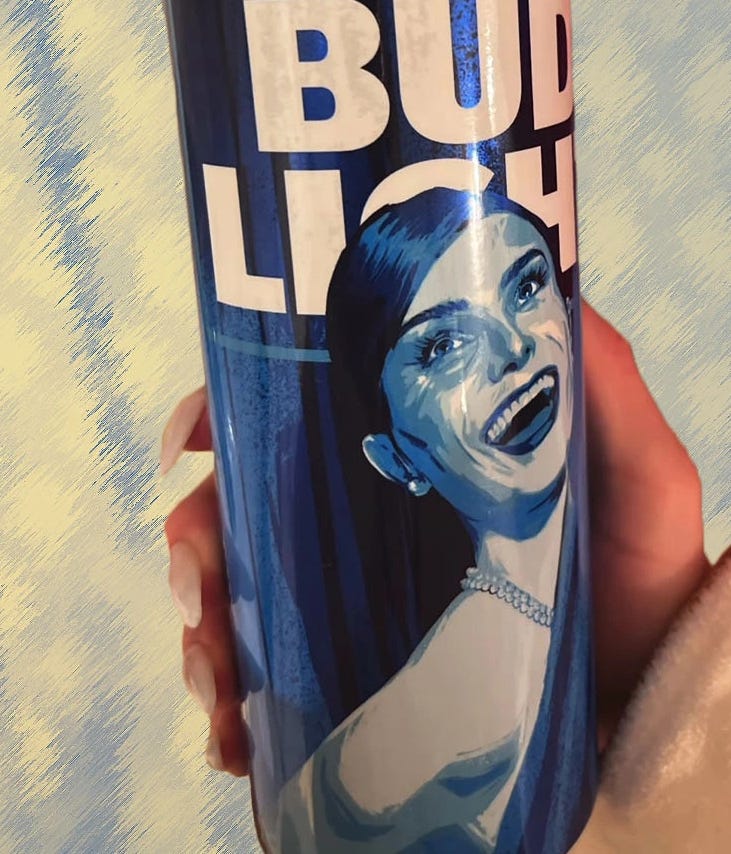The beginning of the backlash
The beginning of the backlash
against gender ideology

It’s very hard to know when to stop. And right now we are witnessing in real time the consequences of pushing an act too far. I’m talking about the literally-revolutionary ideology that tries to pretend the essential differences between males and females are just accidents of upbringing.
As with many errors of the last half-millennium, it is a function of Ockham’s error. Trying to keep things simple — usually a good idea — he denied the objective existence of those things that are shared by many related individual beings. For him, the fact that there are horses would not imply that there would be a horseness independent of each horse, something beyond and behind each individual horse, something that would exist even if there were no more horses. That essential horseness of each horse, in his view, would be in fact only a quality existing in each individual. Almost a coincidence, one could say, and — stretching the idea to the point of absurdness — someday a mare could deliver a chicken instead of a foal.
A few centuries to let the bad idea ferment, and we get to the Marxian assumption of a fundamental plasticity of human nature. That is where every single attempt at creating the Worker’s Paradise blew up: unlike predicted by Marx, human nature refused to change after a few generations of “collective” (in fact governmental) ownership of the means of production. When all people are equal, there will always be some that are “more equal than the others”, as in Orwell’s tale. In all real-life attempts at building Communism, things got exponentially worse, because all eggs were in a single basket (the Party, the central government). Thus, instead of having thousands of psychopaths vying for thousands of seats of power within thousands of different institutions, public and private, all the meanies flocked to the Party and tried to get a seat in the central government. The worst usually did.
However, even if orthodox Marxism fell to the roadside around the turn of the century, its ways of thinking and, especially, the irrational superstitions ingrained in the young by years of learning that nonsense as if it were a law of nature akin to Newton’s Laws make Marx’s cadaver much more smelly than it should. They still believe that History walks toward a paradisiacal goal. That if what is there is destroyed, something better will be brought automatically, in a kind of miracle operated by Marx’s goddess History. That is why they are always pushing for “change”: they really believe that change is always for the better, even if only in the longer term. They truly believe History walks a greatly predictable path toward an earthly paradise, and there would be some superstitions rules that would help one understand it. The most fundamental of these is that Progress always wins. History would know where it wanted to get to, and it would find its path by itself. When it doesn’t walk strictly forward toward that earthly paradise, its setbacks would be essentially temporary and, in fact, just ludicrous swan songs of bygone oppression. On the other hand, also due to that all-so-important Main Superstition, any setback suffered by Progress is antinatural and disgusting.
It’s very interesting, in fact, to see that they substituted a supposed “nature” of History for human nature. The latter would be plastic, while the former would be not only set in stone but basically divine. Any deviation from the path of Progress is blasphemy against History, an anti-natural act or event that must be resisted with all available means. Marxians and Post-Marxians are the most rigid monotheists; History is their über-Allah, and its supposed path is their über-Koran. That is why the brief interregnum of Trump was seen by them as an orgy of wine-guzzling transvestites with dogs at the Kaaba of Mecca would be seen by fire-and-brimstone Taleban preachers: having that orange-haired “regressive” clown replacing Obama in the White House was the worst possible kind of blasphemy against History. For so-called progressives, it was unnatural, blasphemous, and most certainly unfair: he had to have been put there by someone. His followers were evidently deluded fools who missed the train of History; a mere “basket of deplorables”, obviously unable to put him there on their own. There enter the Russkies, then!
Well, while it may certainly be reassuring and comfortable to live in such an illusion about how the world is, to believe that — as in a bowdlerized fairy-tale — one’s side will always win, to have the great goddess History forgive all of one’s personal faults, it certainly doesn’t give one any accuracy in feeling the pulse of society, or even in understanding the real-life consequences of one’s acts. It is undeniable that the society-wrecking efforts of those who see themselves as the Forces of Progress have been enormous in the last decades. Nonetheless, it is due not to any kind of surgical precision in their actions upon (or rather against) society, but to the simple fact that they kept, and keep, pushing all the time. It’s quite easy, after all, when one’s superstitions make the act of destruction one’s only mission. They are sappers, wreckers; building “a better world”, for them, is the role of their goddess History, and needs no planning and no human action. It’s assured, and all they need to do is to destroy what is there, whatever it may be.
And that is how they bit more than they could chew with that gender stuff, and blowback is already coming hard.
Their blindness to the consequences of pushing forward with something that crazy is perfectly understandable; after all, they not only think they are “on the [permanently] winning side”, but their ideological delusions prevent them from realizing the visceral reaction their attack on this particular essential element of human nature would trigger. They deny human nature as a whole, and have been quite successful in denying many key elements of it. The absurd idea that human beings are intrinsically good, and it is society that makes them bad (originally from Rousseau, but coopted by Marx), for instance, is nowadays quite commonly accepted. Likewise, the half-century of socially-accepted contraception made it easier to make the much harder sell of equating homosexual relationships to marriage. Getting the signs and values within racism upside-down, likewise, has been much easier than it would have been to fight racism itself.
(As an aside, it is interesting to notice that nowadays the “mother-ship” of leftism is the American left. They start stuff that trickles down unopposedly first to England, then to Continental Europe, and then — with some filtering and stronger opposition — to the rest of the world. That is why, for instance, the Latin-American left basically repeats the original discourse of the American left, even when it makes no sense at all in the local contexts, and Africa, farther down the trickling path, violently opposes it.)
Denying the essentiality of the sexes, however, hurts much deeper than all previous assaults on human nature, being a direct attack on two of the archetypes in the human psyche that most forcefully trigger the (male) need to protect: the maiden and the mother.
Let me ramble for a while about some accidental aspects of it, and I’ll get back to the main point.
Rambling on birds:
Bird photography is one of my hobbies, and a peculiarity of birds is that the male is often the most beautiful one in the couple; the precise opposite of what happens with us. Nevertheless, the sexual differences in birds have many elements in common with ours: the male is often bigger, he aggressively protects the female, and so on. Altogether, they are much closer to real human relationships than to the dreams of ideologues. Anyway, my point is that males and females are just not the same. If you have males and females in any species, you have essential differences between them. Here’s a couple of couples, shot from the window that is by my side while I write this:
Mr. and Mrs. Saffron Finch (Sicalis flaveola). While she daydreams on the right, he looks straight at me, probably because of the camera noise, ready to protect her from the pesky paparazzi.
Mr. and Mrs. Turquoise Honeycreeper (Dacnis cayana). You can get to her over his cold and blue dead body. Or would it be a cold and dead blue body?
Rambling on grammar and the meaning of words
“Gender” (“genus” in Latin) is primarily a technical term of classical logic; its use in grammar is secondary to that. Basically, “gender” is something that has at least a couple of different “species” within it. This is why we talk about “generical” versus “specific”. Each species, in turn, is a lower gender with other species under it, from the most swapping (“the gender “being” has “imaginary” and “real” as species; the gender “real beings” has “living” and “non-living” as species, and so on) to the smallest and most precisely individual level. Appartenance to genders and species within it is an essential element of any individual being, and the most perfect form of definition is that which gives us the lower gender and the specific difference. For instance, man is a “rational animal”, that is, within the gender of “animals”, man is the only species that can use reason (or choose not to). In grammar, therefore, “gender” is likewise what has some different species within it, and the term can be used for other stuff apart from sex (in sex gender, the species would be “male”, “female”, and “neutral”). “Countable” and “uncountable” (“many” vs. “much”) are species of a gender, too.
Thus, that crazy stuff of using the word “gender” as a flexible substitute for the sex of human beings makes even less sense than it would if “gender” was really strictly a way of stating the grammatical “sex” of words. Even if that were the case, the most one could do would be to assign “neutral” to a human being, instead of “male” or “female”. I guess that would be what they call “non-binary”, and could perhaps be applied to the (very rare) true hermaphrodites. What makes no sense at all, though, is the idea of indistinction that is behind that perversion of the term “gender”. Gender, by definition, is the category above distinct species. If there is no distinction between species, there is no gender. And, obviously, the human gender has two species, male and female.
By the way, the whole “species” thing reminds me of the immortal words of the great Tom Jobim, the bossa-nova composer: “mulher é outro bicho” (“Women are a different species”). He did know women.
Besides, still in the matter of words, “cis” means “this side” and “trans” “the other side”. Therefore, even if a guy could in fact become a woman, he would be a “trans man”, for he would be “beyond man”, “on the other side of man-ness”. Never a “trans woman”. A “trans woman” should be — if such a thing was possible — a woman who “goes to the other side” and becomes a man. This small grammatical fact made it really hard for me to understand that Orwellian newspeak when it suddenly flooded the world. I eventually memorized it as “‘trans’ nowadays means ‘fake”.
Back to the basics
Archetypes (such as “the maiden” and “the mother”) are psychological characters that come, so as to say, hardwired in our minds. Just as an indoor-raised cat, that has never seen a snake, will be scared of any strange cylindrical object, the human mind has its hardwired categories and characters, preparing us to live our lives. It’s part of human nature (that thing “progressives” deny), just as our average body temperature, the fact that we are mammals of a certain average size, that we have two feet and two hands, and grasp stuff with these and walk on those, and so on.
In all human societies, the same archetypes reappear over and over again, with very small variations. Likewise, it is easy to attract the attention of human beings by presenting them with archetypes. We may have never stop to think about one of them, but when we see it there is a kind of gut-level recognition that does get our attention. For instance, in pop culture, one of the stronger pairings of hero and villain is Batman and the Joker. And, moreover, that duo got much stronger traction when darker and heavier images and stories substituted for the light comedic presentation of the characters that was more usual during their first decades. It happens because Batman is (or can be, if presented thus) a great representation of the archetypal shadow, a frightening, secret, and potentially violent part of ourselves, and the Joker is another image of the classical trickster, a chaotic character, at once smart and unpredictable dangerous. A fight between the shadow — especially one in which the shadow tries to integrate itself, to behave well, without ceasing to be dark and violent — and the (external) trickster is much more compelling than, say, a fight between a solar warrior such as Superman and his own trickster figure, Mister Mxyzptlk. The latter dispute has no mystery in it. In a way, it is purely external, and the trickster becomes merely annoying, while the former has many more levels in it: the shadow’s fight to become ordered mirrors one’s own inner fight, while the element of chaos brought in by the trickster makes the shadow darker, more dangerous, and more prone to explode in disordered violence. And so on.
Now for the archetypes that are (rightly) perceived to be under attack, the mother and the maiden. They are archetypes (duh), that is, they are already there. One may perfectly well have never had a mother figure, one can have been raised in a Romanian orphanage or in a Spartan warrior den, but one will always have a hole inside, in the precise shape of a mother. It is one of the natural (that is, apart from any direct divine action) elements that explain, by the way, how all traditional forms of Christianity incorporated so strongly the veneration of the Mother of God. The image of a mother and small child tugs at our hearts, and (especially for men) triggers at the gut level the strongest desire to protect her and, in turn, be protected by her. I’d go even further, and risk saying that Marian icons — a tradition started by St. Luke himself, who painted the first — probably had stronger psychological importance than the icons of Our Lord Himself in the fight against iconoclasm. At the rational level, one may know she doesn’t need our protection, but the archetypal strength of this desire to protect the Mother is much stronger than reason.
The other archetype under attack, the maiden, has an added biological aspect to it that makes the desire to protect her when under attack even stronger. Men are much simpler beings than women, and during that phase of life in which it is physiologically possible to find a mate, have kids with her, and dream of happiness in general, the pull of nubility is absurdly strong. It’s so strong women usually have no idea of how it works, and how strongly a man is affected by the mere vision of a young and fertile woman. Even after that phase of life, even when men’s bodies are no longer seeking a potential mate (the body keeps seeking even when reason tells it to stop; that’s an annoying — and quite dangerous — consequence of Original Sin), nubility is fascinating. Delightful. Amazing. A nubile woman — that is, a maiden — is the flower of flowers, the jewel of jewels. Her smile is brighter than the light of the sun — in fact, I always say that the smile of maidens is what made civilization possible. Virtually everything a young man does is in the hope of being smiled at by a fair maiden. And, furthermore, in the hope of being allowed to become her protector. Of making her become another archetype, that of the mother of his children. Yet again, the fact that Our Lady is at once a maiden and a mother (or rather The Mother, the mother God picked for Himself) makes Marian devotion even more natural for men.
There is a beautiful painting by Eliseu Visconti (not safe for Puritan environments, as it depicts a shirtless maiden; however, one would have to be pretty sick to find it erotic or, much less, pornographic) called “Gioventù” — “youth”, the quality of being young —, that I would often visit at the Museum of Fine Arts, in Rio de Janeiro, when I was a teenager. What attracted me so much to that painting when I was on the verge of becoming a young man seems obvious to me now, after so many decades: it is an attempt at attaining the perfect representation of nubility. That is why it’s called “Youth(ness)”, not “Miss This-or-that”; she is an archetype, the archetype of the maiden. The artist depicted the essential qualities of nubility, much more than an individual person: her fragility (that demands protection), her beauty, her placidness (that promises one day a peaceful home and the emotional protection only a loving wife can give), her chaste demeanor, her orientation towards the future (as she is not a mature woman yet, having just ceased being a child herself). She seems to be about to smile, decorously, but she is not smiling yet; her smile is but a hope, the hope that can bring young men to heroic endeavors. Even the doves by her side — symbols of purity — seem to see her as almost one of them. Curiously, many years after I went there for the last time in the last century, a scientist discovered under that painting a study for another painting by Visconti, in which St. Sebastian (the archetypal male youth, in a way) receives his reward from an angel… that is a fully-blossomed, but still nubile, young woman. While Gioventù is a promise, the maiden/angel in the hidden picture is already able to give the warrior his reward.
Now, having rested our eyes on Visconti’s painting(s), we can compare it to an image that made the rounds these days:
It’s easy to understand why Jordan Peterson (whom I am definitely not a fan of, but he is perfectly right in this) wrote that the deluded young man in the picture above is “parodying women in a manner that makes blackface appear loving.” He could have gone even further (hey, he is a Jungian) and said the poor guy does all he can to be a living caricature of the maiden archetype. In fact, however, all he manages to do is to be the anti-maiden, the non-maiden, the living and aggressive denial of maidenhood and nubility, for all of his “girlhood” claims. His claws (for they have nothing to do with the nails of a woman) holding the can, the cartoon-like depiction of his undeniably masculine face in sharp contrast with his hair, lipstick, and pearls. It is even more than a joke: it is indeed an attack on nubility “that makes blackface appear loving.”
The relationship between that poor deluded young man and nubility is akin to that of his peers in that group of Frisco transvestites who parody nuns’ habits and real saintly nuns. And just as anybody who knows and likes nuns is rightfully offended by their disrespect, anyone who has the gut-level instinctive pull to protect maidens (that is, any sane and healthy man) is offended by that young man’s claim of “girlhood”. “Girlhood” is sacred, magical, mysterious, alluring, enchanting. It has nothing to do with him. It is, in fact, what he attacks with his hateful disguise, just as openly as the Frisco guys attack real nuns.
That is why what could have been just a story about how some beer ads backfired may well be a perfect example of why the progressive perpetual push for demolition went a bit too far. They touched a live wire there, attacking the two archetypes that trigger the most basic and essential male instincts of protection. But it is not something out of the blue, nor is it an isolated incident; it’s only a small part of a huge campaign, endowed with huge funds… and all of it is backfiring everywhere. The Tavistock Clinic — Britain’s trans Mecca — is being closed. Lawmakers in many jurisdictions are passing laws protecting children from hormonal disruption. Polls worldwide show people are sick and tired of all that madness; the stronger the imposition of this particular madness, the stronger the negative reaction is. In other words, the backlash is coming, and coming hard.
It is interesting to notice, though, that opposition to gender ideology is — predictably, according to all we’ve just seen — much more of a male thing. Women do not feel this male urge to protect maidens and mothers; in fact, there is a good amount of truth in the joke that says “understanding women’s minds is not worth the trouble; women understand one another, and they hate one another’s guts”. Besides, the progressives picked well their terminology, by calling “care” what in fact is a very thorough form of child abuse, including hormonal poisoning and psychological manipulation. Women like care. They want to care, and going against something that is unceasingly called “care” in the media is always hard for them. Hey, the welfare state is a consequence of suffragism; female voters tend to vote for more and more care.
It explains, too, why it took so long to reach such a massive level of male backlash: men tend to endure stuff, even disgusting stuff, if doing it will make women happier. So, for instance, the normalization of homosexualism was endured by men; seeing two men behaving as a couple could make men sick, but as women seemed to protect the guys who were into it and they didn’t seem to attack (or, obviously, compete for) women, it was endurable. Likewise, female-to-male transvestism, even when it comes with harsher stuff (breast removal, hormones, whatever), may be very sad and faintly ridiculous, but to go against it openly would be to go against those women, even if they are deluded and self-harming women, and few men would do it. Male-to-female transvestism, on the other hand, is (rightfully) perceived as an attack on women, perpetrated by men. It fulfills all the conditions that trigger the male instinct to protect maidens and mothers. These attacks are at least mean parodies of both maiden and mother archetypes (as rightly identified by Dr. Peterson), and at a worse level, there is a very real threat of physical or moral harm to women by male intruders in what should be female-only environments, from jails to bathrooms and vestiaries, to athletic fields. And that is where they touched the live wire. No sane and healthy man can watch the women he loves — mother, daughter, potential or real girlfriend; all of them are represented in the archetypes we have seen — being attacked without being overcome by a gut-level need to protect them.
It is too early to know how far the backlash will go. Although it is quite probable that more terrain will be regained than just the strict terrain gained by this particular attack on such a sensitive pair of archetypes, just like a tsunami that goes much farther over land than the previous level of the tide before it retreated, the deeper level of societal destruction already attained by the Progress-worshipping folks cannot be measured.
(Just as an illustration, I asked Substack’s Artificial Idiocy to generate an image of a “nubile woman”. It produced a disgusting pornographic image of an objectified woman in a degrading position. As so-called A.I. is just a pattern recognition-and-reproduction mechanism, it means nubility and degradation are already strongly mixed in the stuff they feed the A.I. with.)
Of course, the usual culprits will keep pushing for what they see as “progress”, and their very tone-deafness will make them see the rising reaction as an unpredictable, disgusting, blasphemous, and unnatural occurrence, incensing them even further. It is quite probable, in fact, that this whole thing will become a kind of secret handshake used to recognize their partisans, who will keep allegiance to the idea of fundamental plasticity of sexes. They may try to go in a different direction (for instance, pushing for official recognition of polygamy, thus getting support from apparently-conservative Mormons) or just keep their attack fronts scattered (news of people “getting married to” themselves, trees, dogs, or whatever), or even revert to a track that they more or less abandoned after the (also archetypal-based) backlash it caused, and try again their hands at the sexualization of children. After all, before they left it aside they had already won several quite important victories, having managed to confuse stuff to the point that legal definitions replaced biological truths, to the point that having young men in their twenties attracted to 17-y.o. young ladies is nowadays often branded as if those healthy young men were child abusers. The disgusting normalization of sexual relationships between kids in their early teens, of course, has also been a practical victory paving the way to the societal (and legal) acceptance of letting older perverts join their games.
It is always easier to attack and destroy than it is to defend and rebuild, and it makes their work easier. On the other hand, nature always reverts to the mean; natural institutions, such as monogamous marriages, may be attacked and even seemingly disappear for some time, but they will be back even stronger later. That is why their crazy superstition of being on “the right side of [a predictable and goal-oriented] History” may give them temporary advantages, especially as a motive for destructive enthusiasm, but as soon as they go too far in any direction a backlash occurs, and everything reverts back to the mean.
Meanwhile, all we can do is to harken the words of the Cardinal Pie of Poitiers:
My brothers, all of you, if you are condemned to see the triumph of evil, never applaud it. Never say to evil: you are good; to decadence: you are progress; to the night: you are light; to death: you are life.
Source: A Thomist Worldview




Comments
Post a Comment